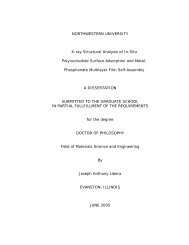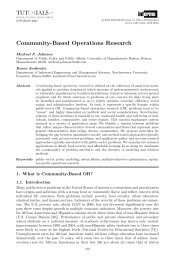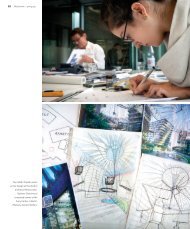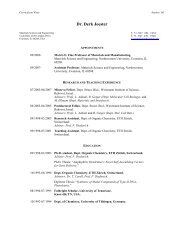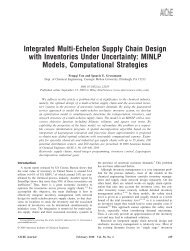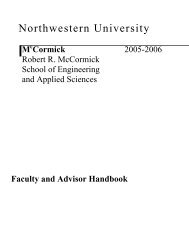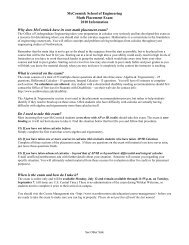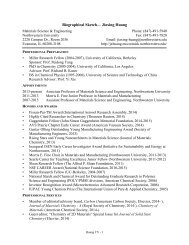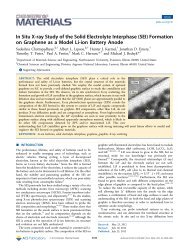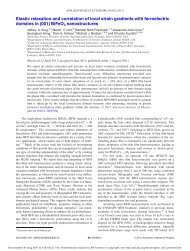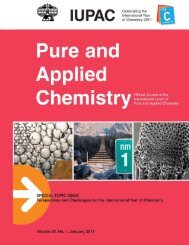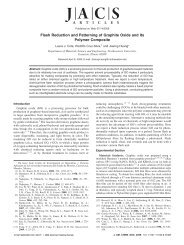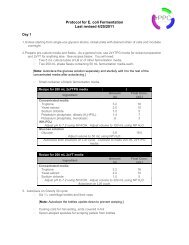Controlled Growth of Platinum Nanoparticles on ... - Energy Systems
Controlled Growth of Platinum Nanoparticles on ... - Energy Systems
Controlled Growth of Platinum Nanoparticles on ... - Energy Systems
Create successful ePaper yourself
Turn your PDF publications into a flip-book with our unique Google optimized e-Paper software.
Volume 5 · No. 6 – March 20 2009<br />
D15063<br />
www.small-journal.com<br />
6/2009<br />
<str<strong>on</strong>g>C<strong>on</strong>trolled</str<strong>on</strong>g> <str<strong>on</strong>g>Growth</str<strong>on</strong>g> <str<strong>on</strong>g>of</str<strong>on</strong>g> <str<strong>on</strong>g>Platinum</str<strong>on</strong>g> <str<strong>on</strong>g>Nanoparticles</str<strong>on</strong>g> <strong>on</strong> Str<strong>on</strong>tium Titanate<br />
Nanocubes by Atomic Layer Depositi<strong>on</strong><br />
M. J. Bedzyk et al.
full papers<br />
Nanoparticle growth<br />
<str<strong>on</strong>g>C<strong>on</strong>trolled</str<strong>on</strong>g> <str<strong>on</strong>g>Growth</str<strong>on</strong>g> <str<strong>on</strong>g>of</str<strong>on</strong>g> <str<strong>on</strong>g>Platinum</str<strong>on</strong>g> <str<strong>on</strong>g>Nanoparticles</str<strong>on</strong>g> <strong>on</strong> Str<strong>on</strong>tium<br />
Titanate Nanocubes by Atomic Layer Depositi<strong>on</strong><br />
Steven T. Christensen, Jeffrey W. Elam, Federico A. Rabuffetti, Qing Ma, Steven<br />
J. Weigand, Bye<strong>on</strong>gdu Lee, Soenke Seifert, Peter C. Stair, Kenneth<br />
R. Poeppelmeier, Mark C. Hersam, and Michael J. Bedzyk*<br />
With an eye toward using surface morphology to enhance heterogeneous<br />
catalysis, Pt nanoparticles are grown by atomic layer depositi<strong>on</strong> (ALD) <strong>on</strong><br />
the surfaces <str<strong>on</strong>g>of</str<strong>on</strong>g> SrTiO 3 nanocubes. The size, dispersi<strong>on</strong>, and chemical state<br />
<str<strong>on</strong>g>of</str<strong>on</strong>g> the Pt nanoparticles are c<strong>on</strong>trolled by the number <str<strong>on</strong>g>of</str<strong>on</strong>g> ALD growth cycles.<br />
The SrTiO 3 nanocubes average 60 nm <strong>on</strong> a side with {001} faces. The Pt<br />
loading increases linearly with Pt ALD cycles to a value <str<strong>on</strong>g>of</str<strong>on</strong>g> 1.1 10 6 gcm 2<br />
after five cycles. Scanning electr<strong>on</strong> microscopy images reveal discrete, welldispersed<br />
Pt nanoparticles. Small- and wide-angle X-ray scattering show<br />
that the Pt nanoparticle spacing and size increase as the number <str<strong>on</strong>g>of</str<strong>on</strong>g> ALD<br />
cycles increases. X-ray absorpti<strong>on</strong> spectroscopy shows a progressi<strong>on</strong> from<br />
platinum(II) oxide to metallic platinum and a decrease in Pt–O b<strong>on</strong>ding<br />
with an increase in Pt–Pt b<strong>on</strong>ding as the number <str<strong>on</strong>g>of</str<strong>on</strong>g> ALD cycles increases.<br />
Keywords:<br />
atomic layer depositi<strong>on</strong><br />
nanoparticles<br />
platinum<br />
str<strong>on</strong>tium titanate<br />
X-ray analysis<br />
1. Introducti<strong>on</strong><br />
[ ] Pr<str<strong>on</strong>g>of</str<strong>on</strong>g>. M. J. Bedzyk, Dr. S. T. Christensen, Pr<str<strong>on</strong>g>of</str<strong>on</strong>g>. M. C. Hersam<br />
Department <str<strong>on</strong>g>of</str<strong>on</strong>g> Materials Science and Engineering<br />
Northwestern University<br />
Evanst<strong>on</strong>, IL 60208-3108 (USA)<br />
E-mail: bedzyk@northwestern.edu<br />
Dr. J. W. Elam<br />
<strong>Energy</strong> <strong>Systems</strong> Divisi<strong>on</strong><br />
Arg<strong>on</strong>ne Nati<strong>on</strong>al Laboratory<br />
Arg<strong>on</strong>ne, IL 60439 (USA)<br />
F. A. Rabuffetti, Pr<str<strong>on</strong>g>of</str<strong>on</strong>g>. P. C. Stair, Pr<str<strong>on</strong>g>of</str<strong>on</strong>g>. K. R. Poeppelmeier,<br />
Pr<str<strong>on</strong>g>of</str<strong>on</strong>g>. M. C. Hersam<br />
Department <str<strong>on</strong>g>of</str<strong>on</strong>g> Chemistry<br />
Northwestern University<br />
Evanst<strong>on</strong>, IL 60208-3108 (USA)<br />
Dr. Q. Ma, Dr. S. J. Weigand<br />
DND CAT – Synchrotr<strong>on</strong> Research Center<br />
Northwestern University<br />
Evanst<strong>on</strong>, IL 60208 (USA)<br />
Dr. B. Lee, Dr. S. Seifert<br />
X-ray Science Divisi<strong>on</strong><br />
Arg<strong>on</strong>ne Nati<strong>on</strong>al Laboratory<br />
Arg<strong>on</strong>ne, IL 60439 (USA)<br />
DOI: 10.1002/smll.200801920<br />
Nanometer-sized noble-metal particles supported <strong>on</strong><br />
metal oxide surfaces can serve as effective heterogeneous<br />
catalysts for accelerating electrochemical, [1–3] photochemical,<br />
[4,5] and thermal processes. [6,7] Effective nanosized noblemetal<br />
catalysts may help to achieve goals in both energy<br />
producti<strong>on</strong> and c<strong>on</strong>servati<strong>on</strong> as well as in reducing polluti<strong>on</strong>.<br />
[8,9] There exists a need for scalable synthetic methods to<br />
prepare well-dispersed nanoparticles <strong>on</strong> complex support<br />
geometries, such as aerogels, porous structures, and other<br />
nanoparticles. Efficient loading <str<strong>on</strong>g>of</str<strong>on</strong>g> the noble-metal catalyst<br />
remains a critical issue in the ec<strong>on</strong>omic viability <str<strong>on</strong>g>of</str<strong>on</strong>g> these<br />
catalyst architectures. Atomic layer depositi<strong>on</strong> (ALD) is a<br />
promising technique for catalyst manufacturing. [10,11]<br />
In the ALD process, a substrate is alternately exposed to<br />
different reactive precursor vapors, which react in a selflimiting<br />
manner to deposit materials in an atomic layer-bylayer<br />
fashi<strong>on</strong>. Although this process typically results in<br />
uniform, c<strong>on</strong>tinuous layers, the ALD <str<strong>on</strong>g>of</str<strong>on</strong>g> noble metals, such<br />
as Pt, has been shown to generate nanoparticles during the<br />
initial stages <str<strong>on</strong>g>of</str<strong>on</strong>g> growth. [12–15] C<strong>on</strong>sequently, ALD can be used<br />
to deposit well-dispersed noble-metal nanoparticles for<br />
catalysis. [2,13,14] The self-limiting surface chemical reacti<strong>on</strong>s<br />
and diffusi<strong>on</strong> <str<strong>on</strong>g>of</str<strong>on</strong>g> the precursor gases render this method easily<br />
scalable. [11]<br />
750 ß 2009 Wiley-VCH Verlag GmbH & Co. KGaA, Weinheim small 2009, 5, No. 6, 750–757
Atomic Layer Depositi<strong>on</strong> <str<strong>on</strong>g>of</str<strong>on</strong>g> <str<strong>on</strong>g>Platinum</str<strong>on</strong>g> <str<strong>on</strong>g>Nanoparticles</str<strong>on</strong>g><br />
It has been recognized that ALD <str<strong>on</strong>g>of</str<strong>on</strong>g>fers the potential for<br />
rati<strong>on</strong>al catalyst design from first-principles calculati<strong>on</strong>s, [16]<br />
but such an undertaking requires a detailed knowledge <str<strong>on</strong>g>of</str<strong>on</strong>g> how<br />
noble-metal nanoparticles nucleate and grow <strong>on</strong> metal oxide<br />
surfaces. In particular, the growth process should be understood<br />
at the length scale <str<strong>on</strong>g>of</str<strong>on</strong>g> nanometers or smaller. To this end,<br />
herein we report an investigati<strong>on</strong> <str<strong>on</strong>g>of</str<strong>on</strong>g> the nucleati<strong>on</strong> and growth<br />
<str<strong>on</strong>g>of</str<strong>on</strong>g> the deposited Pt nanoparticles (termed ALD Pt) by utilizing<br />
nanoscale diagnostic probes. In this study, we use cube-shaped<br />
str<strong>on</strong>tium titanate (SrTiO 3 ; STO) nanoparticle substrates<br />
prepared by sol precipitati<strong>on</strong>–hydrothermal treatment<br />
because these serve as a realistic, high-surface-area support<br />
that is appropriate for catalytic testing. [17]<br />
The Pt/STO system has been studied as a model<br />
photocatalyst for fuel producti<strong>on</strong>. [18–20] Recently, ALD Pt/<br />
STO nanocubes have shown favorable results as a combusti<strong>on</strong><br />
catalyst. [21] The success <str<strong>on</strong>g>of</str<strong>on</strong>g> the Pt/STO system in these<br />
applicati<strong>on</strong>s lies in the SrTiO 3 support. Due to comparable<br />
bandgaps, SrTiO 3 acts as a UV photocatalyst similar to<br />
TiO 2 , [22] in which phot<strong>on</strong>s generate electr<strong>on</strong>–hole pairs that<br />
catalyze reacti<strong>on</strong>s to produce fuels such as hydrogen or<br />
methanol. In oxidative catalysis, STO as a support material can<br />
reduce unwanted carb<strong>on</strong>aceous buildup. [23] The nucleati<strong>on</strong> <str<strong>on</strong>g>of</str<strong>on</strong>g><br />
ALD Pt <strong>on</strong> the STO nanocubes [17,24] is <str<strong>on</strong>g>of</str<strong>on</strong>g> particular interest as<br />
ALD <str<strong>on</strong>g>of</str<strong>on</strong>g>fers some advantages in cleanliness and precisi<strong>on</strong><br />
when compared to traditi<strong>on</strong>al catalyst preparati<strong>on</strong> methods.<br />
Since STO nanocube faces are reported to have the {001}<br />
orientati<strong>on</strong>, the Pt/STO nanocube system may be readily<br />
compared to our previous study <str<strong>on</strong>g>of</str<strong>on</strong>g> Pt ALD <strong>on</strong> planar, singlecrystal<br />
SrTiO 3 (001). [25]<br />
The original studies <str<strong>on</strong>g>of</str<strong>on</strong>g> the ALD <str<strong>on</strong>g>of</str<strong>on</strong>g> Pt using alternating<br />
exposures to (methylcyclopentadienyl)trimethylplatinum(IV)<br />
(MeCpPtMe 3 ) and oxygen c<strong>on</strong>cluded that this method results<br />
in metallic Pt films; however, these investigati<strong>on</strong>s did not look<br />
in detail at the early stages <str<strong>on</strong>g>of</str<strong>on</strong>g> growth. [26,27] In particular, the<br />
chemical state, size, and dispersi<strong>on</strong> <str<strong>on</strong>g>of</str<strong>on</strong>g> the platinum nanoparticles<br />
were not explicitly addressed but rather the studies<br />
focused <strong>on</strong> the steady-state growth after several hundred ALD<br />
cycles. The nature <str<strong>on</strong>g>of</str<strong>on</strong>g> the Pt in the early stages <str<strong>on</strong>g>of</str<strong>on</strong>g> growth<br />
remains an open questi<strong>on</strong>, and the nature <str<strong>on</strong>g>of</str<strong>on</strong>g> the underlying<br />
support surface is bound to play a critical role in affecting the<br />
Pt. For instance, in our recent report, we described how the<br />
ALD Pt growth rate is higher than expected <strong>on</strong> SrTiO 3 (001)<br />
and asserted that the STO surface catalyzes the reacti<strong>on</strong> <str<strong>on</strong>g>of</str<strong>on</strong>g> the<br />
MeCpPtMe 3 precursor, and furthermore that Pt surface<br />
diffusi<strong>on</strong> plays an important role in the nucleati<strong>on</strong> process. [25]<br />
These findings raise key issues for synthesizing Pt<br />
nanoparticles <strong>on</strong> SrTiO 3 and other substrate materials by<br />
using ALD. One <str<strong>on</strong>g>of</str<strong>on</strong>g> the key issues in the early stages <str<strong>on</strong>g>of</str<strong>on</strong>g><br />
platinum ALD is the final Pt oxidati<strong>on</strong> state. The c<strong>on</strong>versi<strong>on</strong> <str<strong>on</strong>g>of</str<strong>on</strong>g><br />
platinum from the þ4 oxidati<strong>on</strong> state in the MeCpPtMe 3<br />
precursor to the zero-valent bulk metallic chemical state <strong>on</strong><br />
SrTiO 3 nanocubes <str<strong>on</strong>g>of</str<strong>on</strong>g>fers an intriguing opportunity to study<br />
and adapt ALD-grown nanostructures for applicati<strong>on</strong>s in<br />
catalysis and fuel-cell technologies.<br />
Herein, we utilize the high-resoluti<strong>on</strong> imaging capabilities<br />
<str<strong>on</strong>g>of</str<strong>on</strong>g> scanning electr<strong>on</strong> microscopy (SEM) to c<strong>on</strong>firm the<br />
nanoparticle morphology and dispersi<strong>on</strong>. The platinum<br />
nanoparticle dispersi<strong>on</strong> and size are further explored with<br />
small-angle X-ray scattering (SAXS) and wide-angle X-ray<br />
scattering (WAXS), respectively. The chemical state and the<br />
local atomic coordinati<strong>on</strong> <str<strong>on</strong>g>of</str<strong>on</strong>g> the platinum nanoparticles are<br />
studied by X-ray absorpti<strong>on</strong> spectroscopy (XAS), the former<br />
<str<strong>on</strong>g>of</str<strong>on</strong>g> which is revealed by the X-ray absorpti<strong>on</strong> near-edge<br />
structure (XANES) and the latter by the extended X-ray<br />
absorpti<strong>on</strong> fine structure (EXAFS).<br />
2. Results<br />
2.1. Mass Gain<br />
The uncoated SrTiO 3 nanoparticles are n<strong>on</strong>porous, singlecrystalline,<br />
cube-shaped particles having the {001} faces<br />
primarily exposed, with an average edge length <str<strong>on</strong>g>of</str<strong>on</strong>g> 60 nm,<br />
and a Brunauer–Emmett–Teller surface area <str<strong>on</strong>g>of</str<strong>on</strong>g> 20 m 2 g 1 . [17]<br />
Measuring the mass gain for the cases <str<strong>on</strong>g>of</str<strong>on</strong>g> <strong>on</strong>e to five Pt ALD<br />
growth cycles yielded a linear increase <str<strong>on</strong>g>of</str<strong>on</strong>g> 4.4 wt% Pt per cycle.<br />
By using the SrTiO 3 surface area <str<strong>on</strong>g>of</str<strong>on</strong>g> 20 m 2 g 1 and the<br />
previously observed Pt ALD growth rate <str<strong>on</strong>g>of</str<strong>on</strong>g> 0.5 Å per cycle, [27]<br />
the expected mass gain is 2.1 wt% per cycle. The measured<br />
weight gain is larger by tw<str<strong>on</strong>g>of</str<strong>on</strong>g>old, which indicates a higher initial<br />
growth rate for ALD Pt <strong>on</strong> the SrTiO 3 surface as compared to<br />
the Pt surface. <str<strong>on</strong>g>Growth</str<strong>on</strong>g> rates in ALD are typically dictated by<br />
the number <str<strong>on</strong>g>of</str<strong>on</strong>g> ligands, which remain <strong>on</strong> the surface following<br />
adsorpti<strong>on</strong> <str<strong>on</strong>g>of</str<strong>on</strong>g> the metal precursor because these ligands will<br />
prevent the adsorpti<strong>on</strong> <str<strong>on</strong>g>of</str<strong>on</strong>g> additi<strong>on</strong>al precursor molecules. This<br />
growth rate is not altogether unexpected, as our recent work<br />
<strong>on</strong> ALD Pt films <strong>on</strong> single-crystal SrTiO 3 (001) showed a<br />
similar increased growth rate prior to film closure. [25] The<br />
SrTiO 3 appears to catalyze the ALD leading to an increased<br />
growth rate until a complete film forms.<br />
2.2. Scanning Electr<strong>on</strong> Microscopy<br />
Figure 1 shows SEM images <str<strong>on</strong>g>of</str<strong>on</strong>g> the SrTiO 3 nanocubes<br />
recorded before and after three Pt ALD cycles. Comparis<strong>on</strong> <str<strong>on</strong>g>of</str<strong>on</strong>g><br />
these images clearly reveals the presence <str<strong>on</strong>g>of</str<strong>on</strong>g> Pt nanoparticles<br />
resulting from the ALD treatment. The Pt particles appear to<br />
be 2–3 nm in size, which is at the resoluti<strong>on</strong> limit <str<strong>on</strong>g>of</str<strong>on</strong>g> the<br />
microscope. The Pt nanoparticles are uniformly dispersed <strong>on</strong><br />
all exposed surfaces <str<strong>on</strong>g>of</str<strong>on</strong>g> the SrTiO 3 nanocubes with a 4–8 nm<br />
interparticle spacing.<br />
2.3. X-ray Scattering<br />
The SAXS data are plotted in Figure 2 for the five Pt ALD<br />
cases and the blank SrTiO 3 nanocubes without Pt. The data<br />
Figure 1. SEM images <str<strong>on</strong>g>of</str<strong>on</strong>g> STO nanocubes before (a) and after (b) coating<br />
with Pt nanoparticles using three Pt ALD growth cycles.<br />
small 2009, 5, No. 6, 750–757 ß 2009 Wiley-VCH Verlag GmbH & Co. KGaA, Weinheim www.small-journal.com 751
full papers<br />
M. J. Bedzyk et al.<br />
Figure 2. SAXS data showing the interparticle scattering interference<br />
for the Pt nanoparticles (<str<strong>on</strong>g>of</str<strong>on</strong>g>fset for clarity). The interference leads to a<br />
peak, the positi<strong>on</strong> <str<strong>on</strong>g>of</str<strong>on</strong>g> which yields the interparticle spacing by using<br />
Equati<strong>on</strong> (1). The data show a dependence <strong>on</strong> the number <str<strong>on</strong>g>of</str<strong>on</strong>g> ALD cycles<br />
(0–5 c) for the positi<strong>on</strong> <str<strong>on</strong>g>of</str<strong>on</strong>g> the peak, which has been fitted with a<br />
pseudo-Voigt functi<strong>on</strong> <strong>on</strong> a power-law background (solid lines).<br />
Figure 3. Center-to-center interparticle spacing (D) determined from<br />
the fits shown in Figure 2 and using Equati<strong>on</strong> (1). The linear dependence<br />
<str<strong>on</strong>g>of</str<strong>on</strong>g> D <strong>on</strong> the ALD cycle shows that the number density <str<strong>on</strong>g>of</str<strong>on</strong>g> nanoparticles is<br />
decreasing due to nanoparticle coalescence.<br />
show a broad peak at a scattering vector magnitude <str<strong>on</strong>g>of</str<strong>on</strong>g><br />
q0.15 Å 1 , which is due to the c<strong>on</strong>structive interference from<br />
waves scattered by neighboring platinum nanoparticles and is<br />
related to the average center-to-center spacing (D) between<br />
the nanoparticle as<br />
D ¼ 2p<br />
q p<br />
(1)<br />
The peak positi<strong>on</strong> q p shows a distinct dependence <strong>on</strong> the<br />
number <str<strong>on</strong>g>of</str<strong>on</strong>g> ALD cycles. Fitting a pseudo-Voigt functi<strong>on</strong> with a<br />
power-law background enables the determinati<strong>on</strong> <str<strong>on</strong>g>of</str<strong>on</strong>g> the peak<br />
positi<strong>on</strong>; the solid lines in Figure 2 represent the peak fits. The<br />
fitting results are plotted against the ALD cycle in Figure 3.<br />
The interparticle spacing increases in a linear fashi<strong>on</strong> from 3.5<br />
to 6.3 nm as the number <str<strong>on</strong>g>of</str<strong>on</strong>g> ALD cycles increases and follows a<br />
linear growth law. A linear increase <str<strong>on</strong>g>of</str<strong>on</strong>g> the center-to-center<br />
particle spacing indicates that the number density <str<strong>on</strong>g>of</str<strong>on</strong>g> particles<br />
per unit area is decreasing, which is due to the particles<br />
coalescing.<br />
The WAXS is equivalent to the powder diffracti<strong>on</strong> from<br />
the nanocubes and platinum nanoparticles. An example <str<strong>on</strong>g>of</str<strong>on</strong>g> the<br />
diffracti<strong>on</strong> pattern is shown in Figure 4 for the uncoated<br />
SrTiO 3 nanocubes, where the Bragg peaks have been indexed.<br />
The room-temperature lattice c<strong>on</strong>stants <str<strong>on</strong>g>of</str<strong>on</strong>g> 3.924 Å for cubic-F<br />
Pt and 3.905 Å for cubic-P SrTiO 3 are such that the broadened<br />
Pt Bragg peaks overlap those <str<strong>on</strong>g>of</str<strong>on</strong>g> SrTiO 3 . By using the Scherrer<br />
equati<strong>on</strong> [28] the mean crystallite size (t H ) in the H ¼ hkl<br />
directi<strong>on</strong> can be determined from the full width at half<br />
maximum (FWHM or Dq) <str<strong>on</strong>g>of</str<strong>on</strong>g> the peak as<br />
Figure 4. WAXS data for uncoated SrTiO 3 nanocubes. The Bragg peaks<br />
have been indexed. The positi<strong>on</strong>s and relative intensities <str<strong>on</strong>g>of</str<strong>on</strong>g> the peaks<br />
are c<strong>on</strong>sistent with polycrystalline cubic-P SrTiO 3 with a ¼ 3.90 Å.<br />
The uncoated SrTiO 3 nanocubes were inspected for line<br />
broadening and showed a 40 nm domain size from the (110),<br />
(111), (200), and (211) peaks. This compares to the 60 nm<br />
nanoparticle size from microscopy in Figure 1 and indicates<br />
that the SrTiO 3 nanocubes are single crystals. Figure 5 shows<br />
the (111) Bragg peak for the five ALD cycle and blank SrTiO 3<br />
cases, in which broadening due to the platinum nanoparticles<br />
can be observed. The peak shape was fitted using a double<br />
Lorentzian functi<strong>on</strong> given by<br />
" #<br />
f ðqÞ ¼A ð1 fÞ f<br />
1 þ q þ<br />
q1<br />
1 þ q q0<br />
b 2 b 1<br />
2 0<br />
(3)<br />
t H ¼ 0:9 2p<br />
Dq<br />
(2)<br />
where A is a scaling parameter, f is a mixing parameter<br />
between the two Lorentzians, and the q and b terms give the<br />
752 www.small-journal.com ß 2009 Wiley-VCH Verlag GmbH & Co. KGaA, Weinheim small 2009, 5, No. 6, 750–757
Atomic Layer Depositi<strong>on</strong> <str<strong>on</strong>g>of</str<strong>on</strong>g> <str<strong>on</strong>g>Platinum</str<strong>on</strong>g> <str<strong>on</strong>g>Nanoparticles</str<strong>on</strong>g><br />
Figure 5. Line broadening effects <str<strong>on</strong>g>of</str<strong>on</strong>g> the (111) diffracti<strong>on</strong> peak due to<br />
the Pt nanoparticle size for the case <str<strong>on</strong>g>of</str<strong>on</strong>g> five Pt ALD cycles. An uncoated<br />
SrTiO 3 pattern (0 c) has been overlaid to illustrate the effect. The<br />
broadening was fitted to Equati<strong>on</strong> (3) where the FWHM measured for the<br />
Pt nanoparticles could yield the crystallite size by using Equati<strong>on</strong> (2).<br />
Figure 7. Normalized X-ray absorpti<strong>on</strong> cross secti<strong>on</strong>s for the five ALD<br />
samples, a Pt foil reference, a platinum(II) oxide reference, and a<br />
platinum(IV) oxide reference. The line shape <str<strong>on</strong>g>of</str<strong>on</strong>g> the spectra suggests<br />
that at <strong>on</strong>e ALD cycle the platinum is in a similar state to platinum in PtO<br />
and as the number <str<strong>on</strong>g>of</str<strong>on</strong>g> ALD cycles increases, the platinum chemical state<br />
progresses to that <str<strong>on</strong>g>of</str<strong>on</strong>g> Pt metal. Fitting <str<strong>on</strong>g>of</str<strong>on</strong>g> the ALD spectra to a linear<br />
combinati<strong>on</strong> <str<strong>on</strong>g>of</str<strong>on</strong>g> the Pt foil reference and PtO reference produced the<br />
results in Table 2.<br />
Figure 6. <str<strong>on</strong>g>Platinum</str<strong>on</strong>g> domain crystallite size (t 111 ) determined from lineshape<br />
analysis <str<strong>on</strong>g>of</str<strong>on</strong>g> the WAXS data, like that displayed in Figure 5. The<br />
linear growth trend is c<strong>on</strong>sistent with nanoparticle growth for ALD.<br />
peak positi<strong>on</strong>s and widths, respectively. The domain size is<br />
then determined by using Equati<strong>on</strong> (2) and the 2 b 0 term for<br />
the FWHM <str<strong>on</strong>g>of</str<strong>on</strong>g> a Lorentzian. The broadening for the Pt(200)<br />
peaks was not as marked and c<strong>on</strong>sequently did not yield useful<br />
informati<strong>on</strong>. Figure 6 plots the Pt crystallite size for the (111)<br />
peak for two to five ALD cycles, which shows that t 111<br />
increases from 1.0 to 2.7 nm and again shows a linear growth<br />
trend. The line width for the <strong>on</strong>e-cycle case was too large to<br />
determine the particle size, but based <strong>on</strong> the linear regressi<strong>on</strong><br />
for the other cases, the particle size would be 0.7 nm.<br />
2.4. X-ray Absorpti<strong>on</strong> Spectroscopy<br />
XANES in the set <str<strong>on</strong>g>of</str<strong>on</strong>g> X-ray absorpti<strong>on</strong> spectra shown in<br />
Figure 7 indicates a change in the chemical state <str<strong>on</strong>g>of</str<strong>on</strong>g> the<br />
platinum as the number <str<strong>on</strong>g>of</str<strong>on</strong>g> Pt ALD growth cycles changes. The<br />
normalized absorpti<strong>on</strong> cross secti<strong>on</strong>s <str<strong>on</strong>g>of</str<strong>on</strong>g> Figure 7 include the<br />
five ALD cases, a platinum-metal foil, and two platinum<br />
oxides: PtO and PtO 2 . The measured Pt L 3 absorpti<strong>on</strong> edges<br />
(relative to E 0 ¼ 11 564 eV) are given in Table 1. The three-,<br />
four-, and five-cycle cases show no significant shift in E 0 ,<br />
whereas the <strong>on</strong>e- and two-cycle cases show a shift <str<strong>on</strong>g>of</str<strong>on</strong>g><br />
DE 0 ¼þ1 eV, which is c<strong>on</strong>sistent with oxidized platinum. In<br />
additi<strong>on</strong> to the edge positi<strong>on</strong>, the XANES regi<strong>on</strong><br />
(E 0 100 eV < E < E 0 þ 40 eV) provides additi<strong>on</strong>al informati<strong>on</strong><br />
regarding the chemical state <str<strong>on</strong>g>of</str<strong>on</strong>g> the Pt. The line shape <str<strong>on</strong>g>of</str<strong>on</strong>g><br />
the <strong>on</strong>e-cycle platinum XANES sample compares favorably<br />
with that <str<strong>on</strong>g>of</str<strong>on</strong>g> the PtO standard shown in Figure 7. The XANES<br />
then transiti<strong>on</strong>s to that <str<strong>on</strong>g>of</str<strong>on</strong>g> bulk metallic platinum as the<br />
number <str<strong>on</strong>g>of</str<strong>on</strong>g> cycles increases. In additi<strong>on</strong> to the DE 0 shift from<br />
E 0 menti<strong>on</strong>ed above, the white-line intensity increases as the<br />
number <str<strong>on</strong>g>of</str<strong>on</strong>g> ALD cycles decreases. The white-line intensity in<br />
this case is related to the d-electr<strong>on</strong> density <str<strong>on</strong>g>of</str<strong>on</strong>g> states. An<br />
small 2009, 5, No. 6, 750–757 ß 2009 Wiley-VCH Verlag GmbH & Co. KGaA, Weinheim www.small-journal.com 753
full papers<br />
M. J. Bedzyk et al.<br />
Table 1. XAS analysis results for the five ALD samples and references.<br />
The Pt L 3 absorpti<strong>on</strong> edge (E 0 ¼ 11 564 eV) shifts to higher energy as the<br />
platinum becomes oxidized. Also given are the EXAFS fitting results,<br />
which show an increase in the Pt coordinati<strong>on</strong> (N Pt ) and Pt–Pt b<strong>on</strong>d<br />
length (r Pt–Pt ) as the number <str<strong>on</strong>g>of</str<strong>on</strong>g> ALD cycles increases.<br />
Sample Pt L 3 edge shift EXAFS fitting<br />
DE 0 [eV] N Pt r Pt–Pt [Å]<br />
PtO 2 þ2 n.a. [a] n.a.<br />
PtO þ1 n.a. n.a.<br />
1 cycle þ1 0.2 2.70 0.05<br />
2 cycles þ1 1 2.72 0.02<br />
3 cycles 0 2.6 2.74 0.01<br />
4 cycles 0 3.7 2.74 0.01<br />
5 cycles 0 4.4 2.75 0.01<br />
Pt foil 0 12 2.76 0.01<br />
[a] n.a. ¼ not applicable.<br />
increase in the white-line intensity indicates a decrease in the<br />
number <str<strong>on</strong>g>of</str<strong>on</strong>g> electr<strong>on</strong>s in the d orbital. A reducti<strong>on</strong> <str<strong>on</strong>g>of</str<strong>on</strong>g> the<br />
d-electr<strong>on</strong> density <str<strong>on</strong>g>of</str<strong>on</strong>g> states would be c<strong>on</strong>sistent with the<br />
oxidati<strong>on</strong> <str<strong>on</strong>g>of</str<strong>on</strong>g> platinum. A linear combinati<strong>on</strong> fit <str<strong>on</strong>g>of</str<strong>on</strong>g> the XANES<br />
<str<strong>on</strong>g>of</str<strong>on</strong>g> the samples using the Pt and PtO XANES spectra leads to<br />
the results given in Table 2. As the number <str<strong>on</strong>g>of</str<strong>on</strong>g> ALD cycles<br />
increases, the Pt–Pt b<strong>on</strong>d increases from 10 to 57% at the<br />
expense <str<strong>on</strong>g>of</str<strong>on</strong>g> the Pt–O b<strong>on</strong>d.<br />
The Fourier transforms <str<strong>on</strong>g>of</str<strong>on</strong>g> the EXAFS regi<strong>on</strong> (E 0 þ<br />
40 eV < E < E 0 þ 1000 eV) are plotted in Figure 8 for the<br />
various cases. Here, the Pt–O b<strong>on</strong>d is evident at <strong>on</strong>e cycle and<br />
steadily diminishes as the Pt–Pt b<strong>on</strong>d becomes more<br />
prevalent. The Pt–Pt b<strong>on</strong>d was fitted using the ARTEMIS<br />
program [29] in R-space over a wave vector (k) range <str<strong>on</strong>g>of</str<strong>on</strong>g><br />
8–13.95 Å 1 and a k-weight factor <str<strong>on</strong>g>of</str<strong>on</strong>g> k 2 . The fitting results<br />
given in Table 1 show the effect <str<strong>on</strong>g>of</str<strong>on</strong>g> the platinum coverage,<br />
where the coordinati<strong>on</strong> (N Pt ) and the Pt–Pt b<strong>on</strong>d length<br />
(r Pt–Pt ) increase with each ALD cycle. The Pt coordinati<strong>on</strong><br />
also increases effectively from zero to 4.4 as the ALD cycles<br />
increase.<br />
For the Pt–O b<strong>on</strong>d, the best results were obtained with a<br />
slightly different fitting approach. Using the XANES linear<br />
combinati<strong>on</strong> results from Table 2, the fracti<strong>on</strong> <str<strong>on</strong>g>of</str<strong>on</strong>g> the Pt foil<br />
spectrum was subtracted from the ALD spectra to yield a<br />
partial absorpti<strong>on</strong> cross secti<strong>on</strong>. This cross secti<strong>on</strong> was then<br />
fitted using ARTEMIS to extract the Pt–O b<strong>on</strong>d length for the<br />
various cases. The fitting for Pt–O occurred over a k range <str<strong>on</strong>g>of</str<strong>on</strong>g><br />
3–7.8 Å 1 , where the oxygen backscattering amplitude<br />
Table 2. XANES spectra <str<strong>on</strong>g>of</str<strong>on</strong>g> the ALD samples shown in Figure 7 are fitted<br />
to a linear combinati<strong>on</strong> <str<strong>on</strong>g>of</str<strong>on</strong>g> the Pt foil and PtO reference spectra to<br />
determine the relative amount <str<strong>on</strong>g>of</str<strong>on</strong>g> Pt in the bulk metallic and oxidized<br />
chemical states.<br />
Sample % Pt % PtO<br />
1 cycle 10 90<br />
2 cycles 23 77<br />
3 cycles 35 65<br />
4 cycles 48 52<br />
5 cycles 57 43<br />
Figure 8. Magnitude <str<strong>on</strong>g>of</str<strong>on</strong>g> the Fourier transform <str<strong>on</strong>g>of</str<strong>on</strong>g> the EXAFS for Pt–Pt and<br />
Pt–O b<strong>on</strong>ding. As the number <str<strong>on</strong>g>of</str<strong>on</strong>g> ALD cycles increases, the Pt–O b<strong>on</strong>d<br />
diminishes as the Pt–Pt b<strong>on</strong>d increases. These data were fitted to<br />
produce the results reported in Table 1.<br />
essentially locates, and a k-weight factor <str<strong>on</strong>g>of</str<strong>on</strong>g> k 1 . For all<br />
cases, the Pt–O b<strong>on</strong>d length was determined to be<br />
r Pt–O ¼ 1.98 0.03 Å. The Pt–O b<strong>on</strong>d length for a tetrag<strong>on</strong>al<br />
PtO crystal structure [30] is 2.04 Å with a coordinati<strong>on</strong> (N PtO )<br />
<str<strong>on</strong>g>of</str<strong>on</strong>g> 4. The Pt–O coordinati<strong>on</strong> from the data could not be<br />
obtained reliably due to the method <str<strong>on</strong>g>of</str<strong>on</strong>g> using partial absorpti<strong>on</strong><br />
cross secti<strong>on</strong>s.<br />
3. Discussi<strong>on</strong><br />
The discrete nanoparticles observed in the SEM images <str<strong>on</strong>g>of</str<strong>on</strong>g><br />
Figure 1 are c<strong>on</strong>sistent with the results for ALD Pt <strong>on</strong> aerogels<br />
reported by King et al., where the Pt loading was <strong>on</strong> the order<br />
<str<strong>on</strong>g>of</str<strong>on</strong>g> 0.05 mg cm 2 . [14] This Pt loading is less than the 1 mg cm 2<br />
projected by Liu et al. as the target for the ec<strong>on</strong>omic viability<br />
<str<strong>on</strong>g>of</str<strong>on</strong>g> direct methanol fuel cells. [1] We can compare these figures<br />
to our results in two ways. First, using the 20 m 2 g 1 surface <str<strong>on</strong>g>of</str<strong>on</strong>g><br />
the STO nanocubes and the 4.4 wt% Pt per ALD growth cycle<br />
from the mass gain, the Pt loading is 1.1 10 3 mg cm 2 for<br />
five ALD cycles. The Pt loading (Q) may also be calculated<br />
from the SAXS and WAXS analysis by using the following<br />
754 www.small-journal.com ß 2009 Wiley-VCH Verlag GmbH & Co. KGaA, Weinheim small 2009, 5, No. 6, 750–757
Atomic Layer Depositi<strong>on</strong> <str<strong>on</strong>g>of</str<strong>on</strong>g> <str<strong>on</strong>g>Platinum</str<strong>on</strong>g> <str<strong>on</strong>g>Nanoparticles</str<strong>on</strong>g><br />
relati<strong>on</strong>ship [Eq. (4)]:<br />
Q ¼ V pr<br />
D 2 (4)<br />
where V p is the particle volume and r is the mass density. For<br />
the case <str<strong>on</strong>g>of</str<strong>on</strong>g> five ALD cycles in which the mean nanoparticle<br />
size t 111 ¼ 3 nm and mean center-to-center distance D ¼ 6 nm,<br />
a hemispherical particle at the bulk density <str<strong>on</strong>g>of</str<strong>on</strong>g> platinum<br />
(21.45 g cm 3 ) would give Q 3 10 3 mg cm 2 , which is in<br />
reas<strong>on</strong>able agreement with the measured weight gain.<br />
<str<strong>on</strong>g>Nanoparticles</str<strong>on</strong>g> <str<strong>on</strong>g>of</str<strong>on</strong>g> this size range are likely to show a size–<br />
property relati<strong>on</strong>ship for which chemical activity will vary<br />
appreciably over a few nanometers. [31–33] Related to size–<br />
property effects are changes in the catalyst b<strong>on</strong>ding and<br />
chemical state. The X-ray scattering data show that the Pt<br />
nanoparticle size and spacing correlate with the number <str<strong>on</strong>g>of</str<strong>on</strong>g><br />
ALD growth cycles. C<strong>on</strong>sequently, we can relate the<br />
coordinati<strong>on</strong>, b<strong>on</strong>d properties, and chemical state to the size<br />
<str<strong>on</strong>g>of</str<strong>on</strong>g> the nanoparticle. The data show a c<strong>on</strong>tracti<strong>on</strong> <str<strong>on</strong>g>of</str<strong>on</strong>g> the Pt–Pt<br />
b<strong>on</strong>d as the nanoparticle size (ALD cycles) decreases. B<strong>on</strong>d<br />
c<strong>on</strong>tracti<strong>on</strong>s <str<strong>on</strong>g>of</str<strong>on</strong>g> this nature have been observed for platinum<br />
[34,35] and could play an important role in the catalytic<br />
activity, as has been dem<strong>on</strong>strated with gold nanoparticles. [36]<br />
The chemical state <str<strong>on</strong>g>of</str<strong>on</strong>g> the nanoparticle becomes an<br />
interesting area to investigate when c<strong>on</strong>sidering the effects<br />
<str<strong>on</strong>g>of</str<strong>on</strong>g> size <strong>on</strong> nanoparticle properties. However, changes in<br />
platinum activity could be expected through a different<br />
mechanism, as the gold nanoparticle study by Miller et al.<br />
c<strong>on</strong>cluded an electr<strong>on</strong> enrichment <str<strong>on</strong>g>of</str<strong>on</strong>g> the d orbitals. For the<br />
ALD Pt, the white-line intensity increases indicating that the d<br />
orbitals are losing electr<strong>on</strong>s. The positi<strong>on</strong> <str<strong>on</strong>g>of</str<strong>on</strong>g> E 0 for ALD Pt<br />
also suggests that the Pt is oxidized for at least <strong>on</strong>e and two<br />
ALD cycles. The oxidati<strong>on</strong> is also evident in the reduced Pt<br />
coordinati<strong>on</strong> for the cases with fewer ALD cycles from the<br />
EXAFS fitting. Mukerjee and McBreen used XAS measurements<br />
to c<strong>on</strong>clude that the reduced Pt coordinati<strong>on</strong> for smaller<br />
nanoparticles facilitated the adsorpti<strong>on</strong> <str<strong>on</strong>g>of</str<strong>on</strong>g> OH and CO, which<br />
correlated with reduced catalyst activity. [32] With this in mind,<br />
we can now explore the oxidati<strong>on</strong> <str<strong>on</strong>g>of</str<strong>on</strong>g> the ALD Pt nanoparticles<br />
in regard to the c<strong>on</strong>versi<strong>on</strong> <str<strong>on</strong>g>of</str<strong>on</strong>g> the ALD precursor, the role <str<strong>on</strong>g>of</str<strong>on</strong>g><br />
the SrTiO 3 substrate, and interacti<strong>on</strong> with the envir<strong>on</strong>ment<br />
up<strong>on</strong> removal from the ALD reactor.<br />
For metallic ALD materials, the chemical state also<br />
becomes important to c<strong>on</strong>firm c<strong>on</strong>versi<strong>on</strong> from the organometallic<br />
precursor to metallic film. In previous studies <str<strong>on</strong>g>of</str<strong>on</strong>g> Pt<br />
ALD using O 2 and MeCpPtMe 3 , the c<strong>on</strong>versi<strong>on</strong> was high and<br />
the metallic Pt state was observed. [15,25–27,37] These c<strong>on</strong>clusi<strong>on</strong>s<br />
are based <strong>on</strong> measuring the reacti<strong>on</strong> products, and <strong>on</strong><br />
spectroscopy and electrical resistivity measurements. The<br />
oxidati<strong>on</strong> <str<strong>on</strong>g>of</str<strong>on</strong>g> the platinum nanoparticles may be due less to the<br />
c<strong>on</strong>versi<strong>on</strong> <str<strong>on</strong>g>of</str<strong>on</strong>g> MeCpPtMe 3 and more to the role <str<strong>on</strong>g>of</str<strong>on</strong>g> the STO<br />
substrate and the envir<strong>on</strong>ment.<br />
To investigate the effect <str<strong>on</strong>g>of</str<strong>on</strong>g> the STO nanocubes, we<br />
c<strong>on</strong>sidered density functi<strong>on</strong>al theory (DFT) calculati<strong>on</strong>s for<br />
the Pt/SrTiO 3 (001) system. [38] The DFT modeling indicates<br />
that the Pt will prefer to bind to the lattice oxygen and that the<br />
stability <str<strong>on</strong>g>of</str<strong>on</strong>g> the Pt/SrTiO 3 structure improved as the Pt–O b<strong>on</strong>d<br />
length approached 2Å. Furthermore, the DFT calculati<strong>on</strong>s<br />
Figure 9. Comparis<strong>on</strong> <str<strong>on</strong>g>of</str<strong>on</strong>g> the surface area to volume ratio (S/V) with the<br />
XANES ratio <str<strong>on</strong>g>of</str<strong>on</strong>g> Pt–O to Pt–Pt b<strong>on</strong>ding. The data sets are in good<br />
agreement for two to four ALD cycles. The case <str<strong>on</strong>g>of</str<strong>on</strong>g> <strong>on</strong>e ALD cycle is<br />
limited as the particle size for the S/V calculati<strong>on</strong> was an extrapolati<strong>on</strong><br />
from Figure 6. The behavior shown here indicates that the Pt oxidati<strong>on</strong><br />
for the small particles is due to interacti<strong>on</strong> with ambient oxygen and<br />
water vapor.<br />
expected a c<strong>on</strong>tracti<strong>on</strong> <str<strong>on</strong>g>of</str<strong>on</strong>g> the Pt–O b<strong>on</strong>d length as the Pt<br />
loading decreased. We measured the Pt–O b<strong>on</strong>d length as<br />
1.98 0.03 Å and the Pt–O b<strong>on</strong>d length for crystalline<br />
platinum(II) oxide is also 2Å. Since there appears to be<br />
no systematic change in the ALD Pt–O b<strong>on</strong>d that may be<br />
compared to the DFT results for SrTiO 3 lattice oxygen, the<br />
nanoparticle oxidati<strong>on</strong> may likely come through interacti<strong>on</strong><br />
with the envir<strong>on</strong>ment. Al<strong>on</strong>g with the nanoparticle size, the<br />
platinum coordinati<strong>on</strong> decreases with the number <str<strong>on</strong>g>of</str<strong>on</strong>g> ALD<br />
cycles. As noted above, the size and coordinati<strong>on</strong> were related<br />
to an increase in the susceptibility to OH adsorpti<strong>on</strong>. [32]<br />
Oxidati<strong>on</strong> by the envir<strong>on</strong>ment, through interacti<strong>on</strong> with<br />
ambient water vapor and/or oxygen, may result up<strong>on</strong> removal<br />
<str<strong>on</strong>g>of</str<strong>on</strong>g> the sample from the reactor.<br />
The surface area to volume ratio (S/V) <str<strong>on</strong>g>of</str<strong>on</strong>g> the Pt<br />
nanoparticles becomes a determining factor for oxidati<strong>on</strong><br />
by the envir<strong>on</strong>ment. If the Pt–O b<strong>on</strong>d results from surface<br />
oxidati<strong>on</strong> <str<strong>on</strong>g>of</str<strong>on</strong>g> the Pt nanoparticles following ambient exposure,<br />
then presumably the number <str<strong>on</strong>g>of</str<strong>on</strong>g> Pt–O versus Pt–Pt b<strong>on</strong>ds<br />
should scale as S/V. Figure 9 shows a plot <str<strong>on</strong>g>of</str<strong>on</strong>g> S/V based <strong>on</strong> the<br />
nanoparticle size measurements from WAXS for a hemispherical<br />
particle compared against the relative ratios <str<strong>on</strong>g>of</str<strong>on</strong>g> Pt–O<br />
to Pt–Pt from the XANES analysis. The comparis<strong>on</strong> is quite<br />
good with the excepti<strong>on</strong> <str<strong>on</strong>g>of</str<strong>on</strong>g> <strong>on</strong>e ALD cycle, which may be due<br />
to the fact that this is based <strong>on</strong> an extrapolati<strong>on</strong> <str<strong>on</strong>g>of</str<strong>on</strong>g> the particle<br />
size and the particle may in fact be smaller than 0.7 nm.<br />
Furthermore, the oxidati<strong>on</strong> <str<strong>on</strong>g>of</str<strong>on</strong>g> the smaller nanoparticles, and<br />
c<strong>on</strong>sequently the effect <strong>on</strong> the chemical state, will presumably<br />
be more dramatic for the smaller nanoparticles as they<br />
have less platinum to compensate the electr<strong>on</strong> affinity <str<strong>on</strong>g>of</str<strong>on</strong>g><br />
the O 2 and OH. Thus, it seems likely that nanoparticles <str<strong>on</strong>g>of</str<strong>on</strong>g><br />
this size are susceptible to oxidati<strong>on</strong> by the ambient<br />
envir<strong>on</strong>ment.<br />
small 2009, 5, No. 6, 750–757 ß 2009 Wiley-VCH Verlag GmbH & Co. KGaA, Weinheim www.small-journal.com 755
full papers<br />
4. C<strong>on</strong>clusi<strong>on</strong>s<br />
We have investigated the ALD <str<strong>on</strong>g>of</str<strong>on</strong>g> platinum nanoparticles<br />
<strong>on</strong> cube-shaped STO nanoparticles. Nanostructured materials<br />
<str<strong>on</strong>g>of</str<strong>on</strong>g> this nature <str<strong>on</strong>g>of</str<strong>on</strong>g>fer some significant advantages for applicati<strong>on</strong><br />
in the fuel cell and catalyst fields. These advantages are tied to<br />
the nanoscale structure, morphology, and chemical state <str<strong>on</strong>g>of</str<strong>on</strong>g> the<br />
system. In accordance with this, we have characterized the<br />
depositi<strong>on</strong> at this length scale by using SEM, SAXS, WAXS,<br />
and XAS. The Pt nanoparticles have a size <str<strong>on</strong>g>of</str<strong>on</strong>g> 0.7–3 nm<br />
c<strong>on</strong>trolled by the number <str<strong>on</strong>g>of</str<strong>on</strong>g> ALD growth cycles and are well<br />
dispersed <strong>on</strong> the support. The loading <str<strong>on</strong>g>of</str<strong>on</strong>g> the platinum is<br />
extremely efficient, 10 3 mg cm 2 . The nanoparticles also<br />
show a Pt–Pt b<strong>on</strong>d c<strong>on</strong>tracti<strong>on</strong> and a tendency to become<br />
oxidized as the number <str<strong>on</strong>g>of</str<strong>on</strong>g> ALD cycles decreases. This work<br />
dem<strong>on</strong>strates the flexibility that ALD <str<strong>on</strong>g>of</str<strong>on</strong>g>fers to address many<br />
important issues in noble-metal nanoparticle catalysis.<br />
5. Experimental Secti<strong>on</strong><br />
ALD Pt/STO nanocube preparati<strong>on</strong>: SrTiO 3 nanocubes were<br />
synthesized by following a sol precipitati<strong>on</strong>–hydrothermal treatment<br />
procedure described in Ref. [17], but the autoclave step was<br />
c<strong>on</strong>ducted for 36 h instead <str<strong>on</strong>g>of</str<strong>on</strong>g> 24 h. In the ALD process, the<br />
nanocubes (0.25 g) were spread <strong>on</strong>to a stainless steel tray that<br />
was covered by a stainless steel mesh during depositi<strong>on</strong>. [39] After<br />
loading into the viscous-flow ALD reactor, [40] the SrTiO 3 nanocubes<br />
were cleaned in situ with a flow (400 sccm) <str<strong>on</strong>g>of</str<strong>on</strong>g> oz<strong>on</strong>e in<br />
oxygen (10% O 3 ) at a c<strong>on</strong>stant temperature (300 -C). The ALD <str<strong>on</strong>g>of</str<strong>on</strong>g> Pt<br />
was accomplished by using alternating exposures to MeCpPtMe 3<br />
and oxygen at a c<strong>on</strong>stant temperature (300 -C). [27] During ALD, a<br />
c<strong>on</strong>stant flow (90 sccm) <str<strong>on</strong>g>of</str<strong>on</strong>g> ultrahigh-purity nitrogen (99.995%)<br />
carrier gas was passed through the reactor at a c<strong>on</strong>stant pressure<br />
(0.90 Torr). The MeCpPtMe 3 precursor was heated (50 -C) in a<br />
stainless steel bubbler to increase the vapor pressure. The<br />
reactant exposures lasted 200 s with partial pressures <str<strong>on</strong>g>of</str<strong>on</strong>g> 0.05<br />
Torr for MeCpPtMe 3 and 0.20 Torr for oxygen, and nitrogen purges<br />
<str<strong>on</strong>g>of</str<strong>on</strong>g> 50 s were used between each exposure. For each sample, the<br />
mass was measured with an analytical balance before and after<br />
ALD to determine the Pt loading. The SrTiO 3 nanocubes were<br />
examined before and after the ALD <str<strong>on</strong>g>of</str<strong>on</strong>g> Pt by SEM using a Hitachi<br />
S4700 microscope with a field-emissi<strong>on</strong> gun electr<strong>on</strong>-beam<br />
source.<br />
X-ray experiments: All X-ray data sets were collected at the<br />
Advanced Phot<strong>on</strong> Source (APS) <str<strong>on</strong>g>of</str<strong>on</strong>g> Arg<strong>on</strong>ne Nati<strong>on</strong>al Laboratory.<br />
The powder samples and reference materials were uniformly<br />
spread <strong>on</strong>to transparent tape (3M) and then folded to achieve<br />
appropriate signal levels for the respective scattering and<br />
absorpti<strong>on</strong> measurements, both taken in transmissi<strong>on</strong> mode. A<br />
transparent tape background was collected and removed from the<br />
X-ray scattering data.<br />
The SAXS data sets were collected at the APS 12ID-C<br />
undulator stati<strong>on</strong> with a MAR 165 CCD detector (2048 2048<br />
pixels), where the incident phot<strong>on</strong> energy (E g ¼ 12.00 keV;<br />
l ¼ 1.033 Å) was selected with a Si(111) m<strong>on</strong>ochromator. A series<br />
<str<strong>on</strong>g>of</str<strong>on</strong>g> slits collimated the beam to a size <str<strong>on</strong>g>of</str<strong>on</strong>g> approximately 100 mm<br />
(horiz<strong>on</strong>tal) by 50 mm (vertical). The momentum transfer was<br />
calibrated by using a silver behenate standard and the detectorto-sample<br />
distance was 2.13 m.<br />
The WAXS data were collected at the APS 5ID-D undulator<br />
beamline with a dual-chip 100 200 mm 2 Roper CCD detector.<br />
The incident phot<strong>on</strong> energy (E g ¼ 16.005 keV; l ¼ 0.77466 Å) was<br />
selected by using a Si(111) m<strong>on</strong>ochromator and the beam was<br />
further collimated with three slits to give a size <str<strong>on</strong>g>of</str<strong>on</strong>g> approximately<br />
0.2 0.2 mm 2 . The detector positi<strong>on</strong> relative to the source was<br />
calibrated with a silic<strong>on</strong> diffracti<strong>on</strong> grating (3600 lines mm 2 ;<br />
LightSmyth Technologies, no. SLG-C36-1212-Si). This allowed the<br />
determinati<strong>on</strong> <str<strong>on</strong>g>of</str<strong>on</strong>g> the momentum transfer calibrati<strong>on</strong> and sampleto-detector<br />
distance (235 mm).<br />
The XAS measurements were carried out around the Pt L 3 edge<br />
(E 0 ¼ 11.564 keV) at the bending magnet beamline <str<strong>on</strong>g>of</str<strong>on</strong>g> the DND-CAT<br />
(5BM-D). The X-ray absorpti<strong>on</strong> spectra were collected in fluorescence<br />
mode by using a xen<strong>on</strong>-filled Lytle cell and a Zn filter to<br />
minimize the scattering signals. The X-ray absorpti<strong>on</strong> spectra <str<strong>on</strong>g>of</str<strong>on</strong>g><br />
the reference materials were collected in transmissi<strong>on</strong> mode by<br />
using gas i<strong>on</strong>izati<strong>on</strong> chambers (Oxford Danfysik). The X-ray phot<strong>on</strong><br />
energy was calibrated with a Pt metal foil. During the XAS<br />
measurements, the energy stability was regularly m<strong>on</strong>itored by<br />
simultaneously measuring the Pt foil, which was placed in<br />
between the sec<strong>on</strong>d and third i<strong>on</strong> chambers. The X-ray absorpti<strong>on</strong><br />
spectra were all measured from 200 eV below to 1000 eV<br />
(k 16 Å 1 ) above the absorpti<strong>on</strong> edge. The near-edge spectra<br />
were collected with an energy step <str<strong>on</strong>g>of</str<strong>on</strong>g> 0.5 eV. Data processing was<br />
performed with the ATHENA program. [29]<br />
Acknowledgements<br />
M. J. Bedzyk et al.<br />
This work was supported by the Institute for Catalysis in <strong>Energy</strong><br />
Processes, Northwestern University (NU) (US Department <str<strong>on</strong>g>of</str<strong>on</strong>g><br />
<strong>Energy</strong> Grant DE-FG02-03ER15457) and by facilities support<br />
from the NU Materials Research Center (Nati<strong>on</strong>al Science<br />
Foundati<strong>on</strong> MRSEC Grant DMR-0520513). Arg<strong>on</strong>ne Nati<strong>on</strong>al<br />
Laboratory (ANL) is a US Department <str<strong>on</strong>g>of</str<strong>on</strong>g> <strong>Energy</strong> Office <str<strong>on</strong>g>of</str<strong>on</strong>g><br />
Science Laboratory operated under C<strong>on</strong>tract No. DE-AC02-<br />
06CH11357 by UChicago Arg<strong>on</strong>ne, LLC. X-ray measurements<br />
were performed at ANL’s Advanced Phot<strong>on</strong> Source, Sector 12<br />
(BESSRC), and at Sector 5 (DND-CAT) which is supported in<br />
part by: E. I. DuP<strong>on</strong>t de Nemours & Co., Dow Chemical Co., and<br />
the State <str<strong>on</strong>g>of</str<strong>on</strong>g> Illinois. Electr<strong>on</strong> microscopy was performed at<br />
ANL’s Electr<strong>on</strong> Microscopy Center for Materials Research.<br />
[1] H. S. Liu, C. J. S<strong>on</strong>g, L. Zhang, J. J. Zhang, H. J. Wang, D. P. Wilkins<strong>on</strong>,<br />
J. Power Sources 2006, 155, 95–110.<br />
[2] X. R. Jiang, H. Huang, F. B. Prinz, S. F. Bent, Chem. Mater. 2008, 20,<br />
3897–3905.<br />
[3] S. Alayoglu, A. U. Nilekar, M. Mavrikakis, B. Eichhorn, Nat. Mater.<br />
2008, 7, 333–338.<br />
[4] M. A. Fox, M. T. Dulay, Chem. Rev. 1993, 93, 341–357.<br />
[5] L. Yuliati, H. Yoshida, Chem. Soc. Rev. 2008, 37, 1592–1602.<br />
[6] H. Yoshida, Y. Yazawa, T. Hattori, Catal. Today 2003, 87, 19–28.<br />
[7] M. Lashdaf, J. Lahtinen, M. Lindblad, M. Tiitta, T. Venalainen, H.<br />
Osterholm, Stud. Surf. Sci. Catal. 2004, 154, 1708–1713.<br />
756 www.small-journal.com ß 2009 Wiley-VCH Verlag GmbH & Co. KGaA, Weinheim small 2009, 5, No. 6, 750–757
Atomic Layer Depositi<strong>on</strong> <str<strong>on</strong>g>of</str<strong>on</strong>g> <str<strong>on</strong>g>Platinum</str<strong>on</strong>g> <str<strong>on</strong>g>Nanoparticles</str<strong>on</strong>g><br />
[8] A. T. Bell, Science 2003, 299, 1688–1691.<br />
[9] M. S. Dresselhaus, I. L. Thomas, Nature 2001, 414, 332–337.<br />
[10] M. Ritala, M. Leskela, in Handbook <str<strong>on</strong>g>of</str<strong>on</strong>g> Thin Film Materials, Vol. 1<br />
(Ed.: H. S. Nalwa), Academic Press, San Diego 2002, p. 103.<br />
[11] S. Haukka, E.-L. Lakomaa, T. Suntola, in Adsorpti<strong>on</strong> and its<br />
Applicati<strong>on</strong>s in Industry and Envir<strong>on</strong>mental Protecti<strong>on</strong> (Ed.: A.<br />
Dabrowski), Stud. Surf. Sci. Catal, Vol. 120A, Elsevier, Amsterdam<br />
1999.<br />
[12] J. W. Elam, A. Zinovev, C. Y. Han, H. H. Wang, U. Welp, J. N. Hryn, M.<br />
J. Pellin, Thin Solid Films 2006, 515, 1664–1673.<br />
[13] A. Johanss<strong>on</strong>, J. Lu, J. O. Carlss<strong>on</strong>, M. Boman, J. Appl. Phys. 2004,<br />
96, 5189–5194.<br />
[14] J. S. King, A. Wittstock, J. Biener, S. O. Kucheyev, Y. M. Wang, T. F.<br />
Baumann, S. K. Giri, A. V. Hamza, M. Baeumer, S. F. Bent, Nano<br />
Lett. 2008, 8, 2405–2409.<br />
[15] Y. Zhu, K. A. Dunn, A. E. Kaloyeros, J. Mater. Res. 2007, 22, 1292–<br />
1298.<br />
[16] J. Greeley, M. Mavrikakis, Nat. Mater. 2004, 3, 810–815.<br />
[17] F. A. Rabuffetti, H.-S. Kim, J. A. Enterkin, Y. Wang, C. H. Lanier, L. D.<br />
Marks, K. R. Poeppelmeier, P. C. Stair, Chem. Mater. 2008, 20,<br />
5628–5635.<br />
[18] B. Aurian-Blajeni, M. Halmann, J. Manassen, Solar <strong>Energy</strong> 1980,<br />
25, 165–170.<br />
[19] R. G. Carr, G. A. Somorjai, Nature 1981, 290, 576–577.<br />
[20] A. H. A. Tinnemans, T. P. M. Koster, D. H. M. W. Thewissen, A.<br />
Mackor, Nouv. J. Chim. 1982, 6, 373–379.<br />
[21] W. Setthpun, F. A. Rabuffetti, J. W. Elam, P. C. Stair, K. R. Poeppelmeier,<br />
C. L. Marshall, unpublished.<br />
[22] A. L. Linsebigler, G. Q. Lu, J. T. Yates, Chem. Rev. 1995, 95, 735–<br />
758.<br />
[23] K. Takehira, T. Shishido, M. K<strong>on</strong>do, J. Catal. 2002, 207, 307–316.<br />
[24] Y. B. Mao, S. Banerjee, S. S. W<strong>on</strong>g, J. Am. Chem. Soc. 2003, 125,<br />
15718–15719.<br />
[25] S. T. Christensen, J. W. Elam, B. Lee, Z. Feng, M. J. Bedzyk, M. C.<br />
Hersam, Chem. Mater, 2009, 21, 516–521.<br />
[26] T. Aalt<strong>on</strong>en, A. Rahtu, M. Ritala, M. Leskela, Electrochem. Solid-<br />
State Lett. 2003, 6, C130–C133.<br />
[27] T. Aalt<strong>on</strong>en, M. Ritala, T. Sajavaara, J. Kein<strong>on</strong>en, M. Leskela, Chem.<br />
Mater. 2003, 15, 1924–1928.<br />
[28] B. E. Warren, X-ray Diffracti<strong>on</strong>, Dover, New York 1990.<br />
[29] B. Ravel, M. Newville, J. Synchrotr<strong>on</strong> Radiat. 2005, 12, 537–541.<br />
[30] W. J. Moore, L. Pauling, J. Am. Chem. Soc. 1941, 63, 1392–1394.<br />
[31] T. Frelink, W. Visscher, J. A. R. Vanveen, J. Electroanal. Chem. 1995,<br />
382, 65–72.<br />
[32] S. Mukerjee, J. McBreen, J. Electroanal. Chem. 1998, 448, 163–<br />
171.<br />
[33] S. Park, Y. Xie, M. J. Weaver, Langmuir 2002, 18, 5792–5798.<br />
[34] M. Klimenkov, S. Nepijko, H. Kuhlenbeck, M. Baumer, R. Schlogl,<br />
H. J. Freund, Surf. Sci. 1997, 391, 27–36.<br />
[35] M. K. Oudenhuijzen, J. H. Bitter, D. C. K<strong>on</strong>ingsberger, J. Phys. Chem.<br />
B 2001, 105, 4616–4622.<br />
[36] J. T. Miller, A. J. Kropf, Y. Zha, J. R. Regalbuto, L. Delannoy, C. Louis,<br />
E. Bus, J. A. van Bokhoven, J. Catal. 2006, 240, 222–234.<br />
[37] T. Aalt<strong>on</strong>en, M. Ritala, Y. L. Tung, Y. Chi, K. Arstila, K. Meinander, M.<br />
Leskela, J. Mater. Res. 2004, 19, 3353–3358.<br />
[38] A. Asthagiri, D. S. Sholl, J. Chem. Phys. 2002, 116, 9914–9925.<br />
[39] J. A. Libera, J. W. Elam, M. J. Pellin, Thin Solid Films 2008, 516,<br />
6158–6166.<br />
[40] J. W. Elam, M. D. Gr<strong>on</strong>er, S. M. George, Rev. Sci. Instrum. 2002, 73,<br />
2981–2987.<br />
Received: December 19, 2008<br />
small 2009, 5, No. 6, 750–757 ß 2009 Wiley-VCH Verlag GmbH & Co. KGaA, Weinheim www.small-journal.com 757



